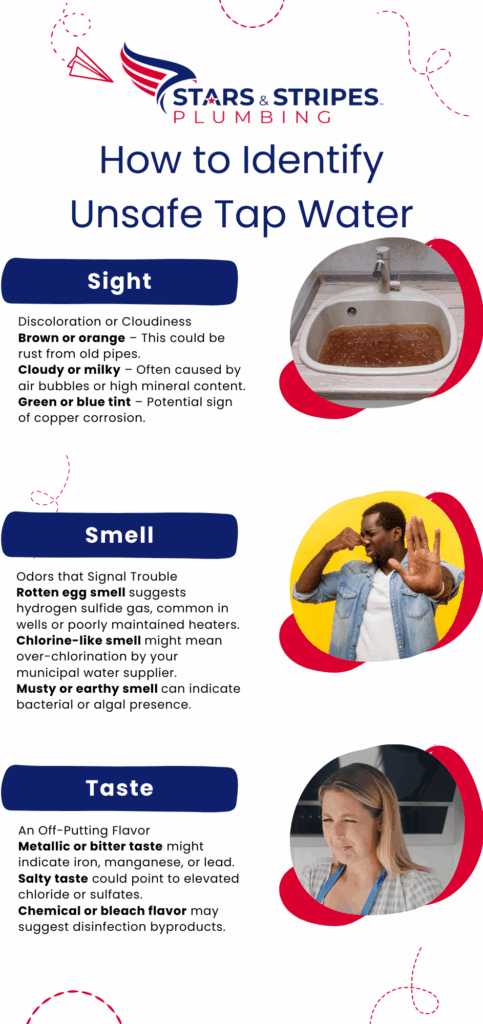There’s a certain pride in maintaining a well-run home. Every detail matters—from your HVAC filters to the sound of your sump pump. But what about the water running from your faucet? If you’re like most homeowners, you rarely question it—until something doesn’t seem right.
At Stars and Stripes Plumbing, we know what it means to take responsibility seriously. As a veteran-owned, community-rooted company, we’ve seen firsthand how hidden plumbing issues—like contaminated tap water—can undermine the health and safety of a household. Our mission is to help families across Washington take charge of their home’s water quality with confidence, clarity, and care.
In this guide, we’ll show you how to identify signs your tap water may be unsafe, what causes those issues, and what steps you can take to restore trust in your plumbing.
How to Identify Unsafe Tap Water: Visual, Smell, and Taste Clues
Not all water contamination is visible to the naked eye—but many times, your senses offer the first line of defense.
Sight: Discoloration or Cloudiness
If your water appears:
- Brown or orange – This could be rust from old pipes.
- Cloudy or milky – Often caused by air bubbles or high mineral content.
- Green or blue tint – Potential sign of copper corrosion.
Cloudiness that disappears from the bottom up after the water sits is usually air. Persistent discoloration, however, is worth investigating.
Smell: Odors that Signal Trouble
- Rotten egg smell suggests hydrogen sulfide gas, common in wells or poorly maintained heaters.
- Chlorine-like smell might mean over-chlorination by your municipal water supplier.
- Musty or earthy smell can indicate bacterial or algal presence.
Taste: An Off-Putting Flavor
- Metallic or bitter taste might indicate iron, manganese, or lead.
- Salty taste could point to elevated chloride or sulfates.
- Chemical or bleach flavor may suggest disinfection byproducts.
These sensory clues are warning signs that your water—and potentially your plumbing—needs closer attention.

Why Tap Water Can Become Contaminated
Safe water isn’t just about where it comes from—it’s also about how it travels. Even clean water can be compromised once it enters outdated or damaged plumbing systems.
Aging Plumbing Infrastructure
According to the EPA, lead exposure from pipes remains a serious issue in homes built before 1986. Galvanized steel pipes, once common, are also prone to rust and internal corrosion, which can leak metals or harbor bacteria.
Backflow Contamination
When pressure in your plumbing system reverses, water can flow backward—potentially drawing contaminants from toilets, irrigation systems, or industrial sources into your clean supply. This often occurs without a proper backflow preventer.
Water Heater Sediment
Minerals like calcium and magnesium can accumulate at the bottom of your water heater, creating a breeding ground for bacteria or metallic tastes if not regularly flushed.
Municipal Supply Issues
Even with treatment, municipal water can occasionally carry traces of pesticides, nitrates, or chlorine byproducts—especially after heavy rains, industrial spills, or treatment failures.
For homes using private wells, risks are higher. The CDC advises well owners to test their water annually for bacteria, nitrates, and pH balance, as these systems don’t receive the same oversight as public utilities.
Testing: How to Confirm If Your Water Is Unsafe
Suspecting a problem is one thing—confirming it is another. There are reliable methods to test your tap water for safety and contaminants.
1. At-Home Water Test Kits
These are a quick first step and can detect:
- Lead
- Chlorine
- Hardness (calcium/magnesium levels)
- pH balance
- Nitrates
However, their accuracy varies. They’re best used as a preliminary measure before professional evaluation.
2. Certified Laboratory Testing
For more thorough analysis, submit a sample to a Washington State-certified lab. These facilities test for a broader range of contaminants, including:
- Bacteria like E. coli
- Heavy metals (lead, copper, arsenic)
- Volatile organic compounds (VOCs)
- Fluoride and nitrates
Many counties in Washington provide access to local labs through the Department of Health website, offering peace of mind through detailed, regulated results.
3. Plumbing Inspections
Sometimes the problem isn’t the water source—it’s the plumbing. A licensed plumber professional can inspect your system for:
- Pipe material degradation
- Leaks or blockages
- Improper connections
- Water heater sediment
Routine inspection is especially critical in older homes, where hidden corrosion can quietly compromise safety.
Want to get ahead of plumbing issues? Explore our professional plumbing inspections.
What to Do If Your Water Is Unsafe
If testing confirms contamination, don’t panic. There are solutions—most of which begin with your plumbing system.
Replace Hazardous Pipes
Lead or corroded galvanized pipes should be replaced with modern, safer alternatives like copper or PEX. This ensures clean water delivery and prevents recontamination.
Install Backflow Prevention Devices
These are essential if your system connects to sprinkler systems, garden hoses, or other potential contamination points. They ensure water flows in one direction only—into your home.
Water Heater Maintenance
Flush your heater annually to remove sediment buildup. This not only improves water clarity but also extends the heater’s life and efficiency.
Filtration as a Supplement, Not a Fix
While whole-home or under-sink filters can remove many contaminants, they should never be used as a substitute for correcting the source of contamination—especially if plumbing materials or design are at fault.
If you’re ready to protect your home’s water from the ground up, our plumbing services in Washington are here to help.
Preventing Future Problems with Safe Water Practices
The best way to avoid unsafe tap water is to make preventative maintenance part of your home’s annual routine. Here’s how to stay ahead of the curve:
Schedule Regular Plumbing Inspections
Just like your HVAC system, your plumbing deserves routine attention. Annual inspections catch corrosion, slow leaks, and water quality issues before they escalate.
Test Water Quality Twice a Year
Especially in older homes or those with well systems, semi-annual testing ensures ongoing safety—even when no symptoms are present.
Flush Faucets Regularly
If you’ve been away from home or haven’t used a faucet in a while, run the tap for 1–2 minutes before use. This helps clear stagnant water from pipes, reducing the risk of contamination.
Install Aerator Screens
These devices trap sediment and debris before it exits your faucet—while also being easy to clean or replace.
Educate Everyone in the Home
Family members should know how to recognize changes in water taste, color, or smell—and know who to call if something feels off.
Final Thoughts: Stay Alert, Stay Protected
Safe drinking water isn’t a luxury—it’s a necessity. And like every mission we undertake at Stars and Stripes Plumbing, protecting your home’s water starts with honor, diligence, and clear action.
If you’ve noticed strange smells, discoloration, or taste issues in your water, or you just want to get ahead of potential problems, now is the time to act. With expert plumbing services grounded in integrity and discipline, we’re proud to serve homes across Washington with the same attention to detail we brought to our time in uniform.
Learn More About Our Plumbing Services in Washington
FAQs
Is it dangerous to drink water with a metallic taste?
A metallic taste often indicates iron, copper, or zinc in your water—usually from pipe corrosion. While not always immediately dangerous, long-term exposure to high levels of heavy metals can pose health risks and should be addressed.
How do I know if my pipes are made of lead?
Homes built before 1986 may have lead pipes or lead solder. A licensed plumber can inspect your system and confirm whether replacement is needed.Homes built before 1986 may have lead pipes or lead solder. A licensed plumber can inspect your system and confirm whether replacement is needed.
Can unsafe tap water make you sick?
Yes. Contaminants like bacteria, nitrates, and lead can cause a range of symptoms, from stomach issues to developmental concerns in children. Prompt testing and action are essential to ensure your family’s safety.
Need trustworthy, veteran-led plumbing services in Washington? Stars and Stripes Plumbing is standing by—bringing honor, precision, and protection to your home.

